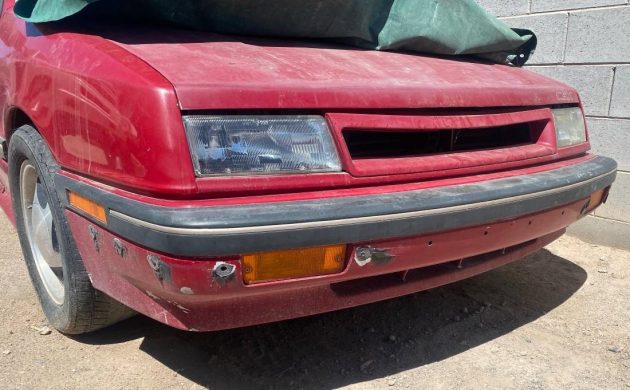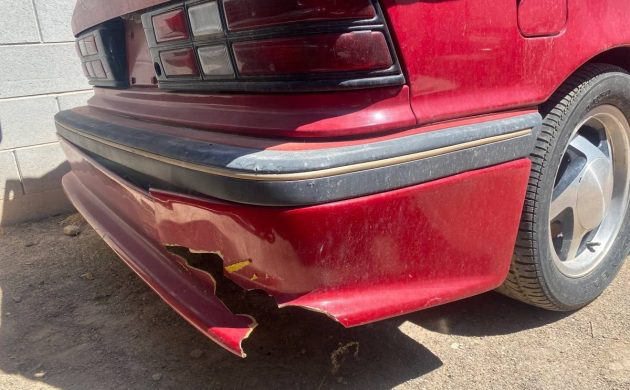While most car people remember Carroll Shelby for his association with Ford Motor Co. and the Shelby Mustang, he had a long-standing relationship with Chrysler, too. One result of that association was the Shelby CSX/VNT which was based on a Dodge Shadow. It was a short-lived exercise that resulted in 500 to 750 cars (depending on the source you read). Here we have a prototype of the vehicle that was one of only two built, but it’s not street-legal and has fallen into a state of disrepair. Our thanks go to Barn Finder T.J. for sleuthing this tip for us!
The CSX/VNT got its name partly from the Variable Nozzle Turbocharger (or VNT) that Shelby added to the mix, along with other Carroll touches. The 2.2-liter I-4 was capable of 175 hp with a torque rating of 205 lb.-ft. with a manual transmission. You could get one in any color you wanted as long as it was black. This prototype is similar to the production car, except it was painted red/maroon.
Depending on the source, this is a 1988 or 1989 vehicle, but Shelby removed the VIN tags before it left his possession. He also signed the hood – with a screwdriver – which sounds like an awful thing to do, but since it has no title (and maybe no way to get one), the car would never be on the street anyway. Shelby let the car go at a “garage sale” in 1994 for an undisclosed amount. It showed up at Barrett-Jackson 14 years later and sold for $33,000 at auction then.
In the past 16 years, the car has fallen into the clutches of Mother Nature, having been stored outdoors for several years. The paint has gone downhill, there is some body damage, the tires are shot, the battery is dead, and we don’t know if it runs. The car has managed to collect 54,000 miles, but how is that possible? Was someone able to get a registration for it without a title? The seller is letting it go with a bill of sale for $20,000 OBO, and trades are possible. It’s in Las Vegas, Nevada, and is available here on craigslist.






This prototype would have made for an awesome version of the Dodge Shadow, like the Dodge Omni GLHS. I dont get why anyone would purchase a car at Barrett-Jackson only to let it sit and rot outside. I remember seeing a Lincoln Continental mark 3 that was purchased in pristine condition at barrett-jackson and then left outside, now its rusty and tired. I digress.
At Barrett maybe someone paid 33K 16 years ago, now it appears to just be a heap. I don’t see the value. A prototype that never went to market maybe. Unless I am missing something this is a parts car now.
Nothing worth $20K here. Whatever made it noteworthy means nothing now. All I see is a tired little Dodge that meant little to whoever last owned it. Now it’s only good for parts….IF THAT.
If you have a Repair or Dealer plate, no registration or title required. Someone probably ran the snot out of this and is now ready to move it along. If someone happened to like the car, why not – it would be almost the only one around.
Meh
I remember back the. When a read about the VNT and it seemed like a great idea. Wonder if cars use this technology still? As far as I’ve casually seen the turbos have fixed vanes?
Cool little car. As said, too bad it’s fallen in to disrepair. Wonder if the front spoiler is still around. But seems like quite an expense for a car you can’t register and drive, unless you have the afore mentioned repair plate. Maybe a Shelby museum piece?
This is a genuinely cool car. Not many out there but somewhat useless without a title. Prototypes are usually the show version (rare) or the used up test vehicle. This one doesn’t have all the markings of a test vehicle but looks plenty abused and neglected. Someone in the previous chain of ownership saw its marketing potential and exploited it. Here it is now.
Another “Delirious” sell when it comes to their asking price.
What it once was is immaterial. It’s junk now.
If Shelby removed the VIN plates prior to the sale, and the car was sold in 1994, then from 1988/1989 through 1994, the car had a VIN plate and could legally be driven on the streets. The assumption here is that “prior to the sale” means immediately before the sale.
Why???
What that plate there in the picture ? That’s just a Shelby plate – correct ?
But, but, but, but, it’s got “Shelby” gee-gaws,,apparently one of the ones I forgot about, was there a Shelby minivan we never heard of? I know of a Shelby Rampage, and Lancer, same thing? I’m sorry, I just can’t fathom the idea of a man that gave us such unbelievable cars, reduced to a mere Dodge Shadow. That sounds like desperation to me, and like all these celebrity vehicles, actually did little for sales. Be that as it may be, I’m sure Mr. Shelby endorsed and liked everyone of his creations. Got to be spinning in his grave seeing one of “his” cars like this. Proof positive, it was just someones beater.
You don’t know the fun that these cars are – and at an affordable price – until you’ve tried one.
But, go ahead and diss them like 95% of the population. We that are in the know will continue to enjoy them at a fraction of the price of cars that it can stomp into the ground.
And, Carroll himself said many times over how proud he was of his achievements with Chrysler products.
The CSX -VNT was very cool, but there were “issues” with the car as it got older. The first production Variable Nozzle Turbocharger in a production car by Garrett (which are now common on Cummins’ 5.9L and 6.7L Turbo Diesels, boost came up VERY QUICK, allowing the car to run with V-8s. But as the car got some miles on the engine, the engines started to go into “Over-Boost” and setting off a “Malfunctioning Indicator Light,” on the dash. The story goes that despite multiple work-arounds, neither Shelby, nor Dodge find a proper solution that resolved the boost control issue.
But Chrysler had a much larger issue that was raising its head, as the EPA didn’t like the idea of running turbo cars rich to quell detonation. As the Turbo-3, DOHC 4-valve per cylinder cars (IROC Daytona and Spirit R/T. They laid down an ultimatum that Turbo Cars would be would have to run under boost at stoichiometric 14.7:1 Air-Fuel Ratios,
This effectively killed the “1st Generation Turbo Cars,” until the Neon SRT-4 came out, with much better Emission Controls and a 4-Valve Head on Every Engine.
BTW, I still have my Shelby Lancer #108, sitting forlornly on the carport awaiting a restoration, after serving as my fun Daily Driver one day in the (hopefully) near future, after I move.
If memory serves me correctly, the VNT was a failure for Chrysler